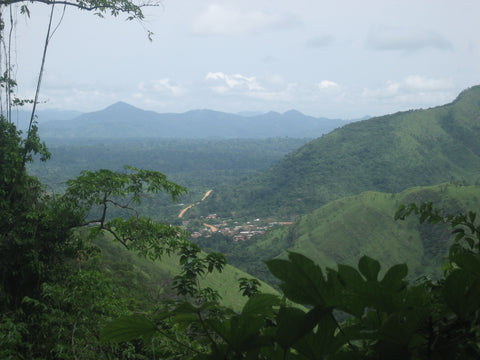A Tropical Tasting Tour of Davis Chocolate

We buy cacao from Fair Trade™ Certified sources around the world. The country of origin, even the specific locations of the farms, influences the taste of the chocolate.
The beans from which we derive chocolate come from native trees of the Amazon, known by the botanical name Theobroma cacao (food of the gods). Almost all production now comes from plantations growing hybrid varieties.Theobroma cacao are evergreen trees. A “shade crop” grown in mountain forests only a 10 degrees north or south of the equator, they enrich soils and protect the ground from erosion, and draw from the specific soil, weather conditions and plant life around them.
Farming Theobroma cacao is a major source of income – and pride – to people living in cocoa growing countries. To the farmers, cocoa is much more than just an agricultural product. The cacao they planted, bred, and selected for centuries are inseparable from their lives, their culture, their land, and their language. Considered a national asset, farmers form cooperatives to develop more sustainable growing practices.
Promoting fairly-traded cacao in stable markets helps drive the double-bottom line of socially-conscious businesses by encouraging sustainable farming practices, providing living wages for laborers and bringing to market a highly desirable product. American chocolate-making artisan Steve De Vries noted in a 2007 interview with The Guardian that access to the isolated rainforests where fine cacao grows is difficult, but pays handsomely in terms of flavor and marketability.
The unique terroir qualities of the cacao varieties give Davis Chocolate™ single-origin bars distinct tastes.
Bolivia

Although most cocoa grows on large plantations, along the Beni River in the lowlands of Bolivia, people still collect wild cacao in the forest and sell it to supplement their income. The wild Bolivian beans are smaller than most cultivated types, belying their big flavor.
Davis Chocolate™ Bolivian chocolate bars have a rich, honey-toned flavor.
Dominican Republic

The Dominican Republic produces two types of cocoa beans, the Hispaniola and the Sanchez variants. Grown in more than 9 provinces, the Dominican Republic quality cocoa beans provide the main source of income to more than 500 farmers who cultivate them.
The Hispaniola/Dominican Republic chocolate bar has light bodied citrus red fruit and gingerbread taste.
Ecuador

Chocolate, once thought to have originated in Mesoamerica around 1,900 B.C., may have first been cultivated in Ecuador. Ecuador and Venezuela have been involved in the exporting of cacao to Europe since the 16th century. Crops such as sugar cane, bananas and coffee began to overtake the cacao plantations more than 100 years ago and in the 1920s, disease nearly wiped out Ecuadoran cacao farming entirely. In 2011, Ecuadoran horticulturalists rediscovered an heirloom variety, Nacional Cacao. Genetically related to the more robust Forasteros variety, the flavor and aroma are similar to that of Criollo cacao.
The Davis Chocolate™ Ecuador chocolate bars have a floral and fruity taste, as well as detectible notes of coffee, nut, vanilla and spice notes, with no bitterness.
Ghana

“The saying 'Cocoa is Ghana, Ghana is Cocoa' tells the important role cocoa plays in the economy of Ghana.” Historical records indicate Dutch missionaries planted cocoa in the coastal areas of Ghana as early as 1815, bringing Theobroma cacao trees from the “New World” forests. However, cacao tree seedlings were not widely distributed to famers until 70 years later. Currently there are six cocoa growing areas, namely Ashanti, Brong Ahafo, Eastern, Volta, Central and Western regions.
Mostly of the Forasteros variety, Ghana chocolate bars from Davis Chocolate™ have a bold, assertive full-bodied flavor that is soothingly less bitter yet strongly chocolatey.
Madagascar

The history of chocolate production in Madagascar dates back to the French colonial times, when the country was a major cocoa exporter. Today almost all cacao grown in Madagascar comes from an area about 50 kilometers in radius and represents less than 1% of the world's cocoa production. Due to natural seasonal flooding, the soil along the Sambirano riverbed is highly enriched with minerals and nutrients and thus, where cocoa plantations are found. Unlike cacao producing regions in other countries, Madagascar harvests cocoa all year round.
The characteristic flavors of Davis Chocolate™ bars from Madagascar are vibrant, crisp and citrusy.
Nicaragua

According to an article on Confectionery News Web site earlier this year, “artisan chocolate makers are welcoming Nicaragua as a rare and blossoming cocoa origin.” Christopher Columbus first tasted cocoa in Nicaragua, mistaking the beans for an almond and noticing the high value it held in the eyes of the indigenous people.
Davis Chocolate™ crafts our Nicaraguan bar to highlight the beans’ delicate hazelnut, tobacco rum and coffee flavors.
Peru

Peru is the third largest grower of cacao in Latin America, cultivated predominantly by small farmers. The Andean region of Peru is particularly well suited for growing Theobroma cacao tress because of the biodiversity of the soil, the climate of the rainforests, the skilled knowledge of the growers, and the access to the Pacific Ocean, for overseas exportation. Peru exports cacao to more than 20 countries, mostly Switzerland and France.
Davis Chocolate™ Peru chocolate tantalizes with flavors of hazelnut, tobacco, rum and coffee.
Venezuela
The climate, geography and skilled farmers in the sea-locked Aragua valley of northern Venezuela all contribute to the production of Criollo cocoa, used in some of the finest chocolates in the world. The purest form of Criollo is Porcelana cocoa originating from Lake Maracaibo in Venezuela. Flavor notes of nuts, caramel, and spice along with the buttery texture make Porcelana chocolate highly coveted. A fragile crop that is difficult to grow, Porcelana seedlings are distributed only to farmers who vow to preserve the historic strain.
Venezuelan chocolate by Davis Chocolate™ is extremely mild with floral notes.
